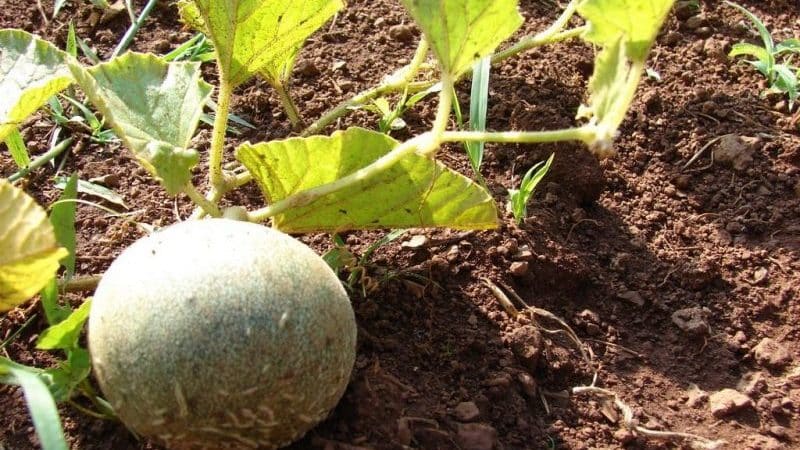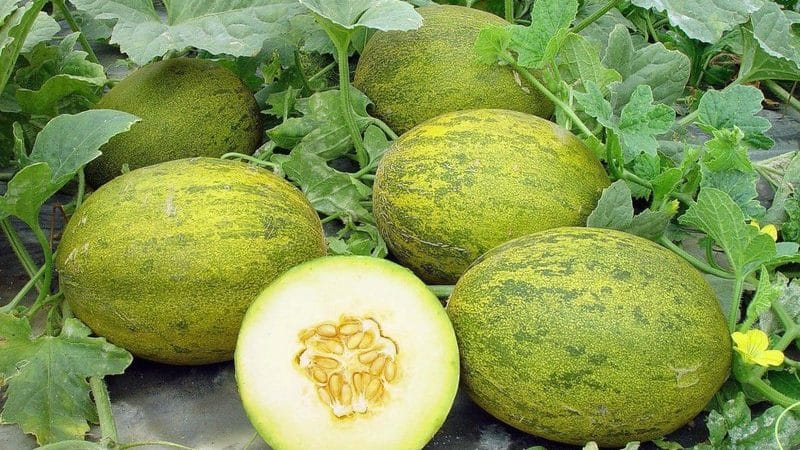Features of growing melon in the Moscow region in open ground
Melon It is considered a heat-loving melon crop, so gardeners in the Moscow region rarely try to grow it in the beds of their plots.
The climate of the Moscow region differs significantly from the hot and dry climate of Central Asia - the homeland of Asian melons. However, if you take into account all the features, create suitable conditions and choose the right variety, growing melon in the Moscow region in open ground will turn out to be a completely feasible undertaking.
What varieties of melon are best to grow in the Moscow region?
Summer near Moscow is short and capricious; late varieties of southern melons do not have time to ripen: they do not have enough time, little sun and heat. But categorically refuse growing melons are not necessary in this region, The main thing is to choose the variety wisely.

Basic requirements for the variety:
- short ripening period (early and mid-early);
- cold-resistant;
- zoned to this climate zone.
Popular varieties for the Moscow region - new and time-tested crops and many years of experience of gardeners:
- Collective farmer - the most popular variety in the Moscow region, cultivated since 1939. Bright yellow, small, round fruits ripen in all weather conditions. Weight up to 1 kg.
- Aikido – an early-ripening, zoned variety with a compact spherical shape and excellent taste. It ripens quickly, it is important to remove it on time. Weight up to 2 kg.
- Altai – a cold-resistant variety, ripens a little later than Kolkhoznitsa. The oblong fruits are covered with a fine mesh, weighing up to 2.5 kg.
- Gold of the Scythians F1 – mid-early productive hybrid. The peel of the fruit is bright yellow, dense, thin, with a pronounced mesh, the flesh is yellow-cream. Each plant ripens up to 3 round melons weighing 1 kg.
- Tamanskaya – early ripening variety. The fruit is medium-sized, oval in shape, with a bright yellow smooth rind. Weight up to 1 kg.
This is an incomplete list of varieties and hybrids that breeders offer for cultivation in the Moscow region - in fact, there are much more of them.
The best seed material is produced by companies whose fields are located in the Moscow region. Such seeds are zoned and are ideal for planting and successful cultivation. For example, the SeDeK company offers the following varieties and hybrids: Alina, Pineapple, Canary, Princess Catherine F1, Princess Diana F1.
Advantages and disadvantages of growing in open ground
The disadvantage of growing in open ground is that this demanding plant can suffer from various weather factors: lack of sunlight and heat, excess moisture, etc.
The advantage is that it is a less expensive method than greenhouse cultivation. In a successful warm summer, growing a melon in the garden is not difficult - its care is minimal, watering is rare.
When is the best time to plant
Seedlings are grown in soluble peat pots. This way, the delicate roots of the seedlings are not damaged when transplanted into the ground, and they do not get sick.
Seeds are sown no earlier than April 15, and seedlings are transplanted into the ground in late May - early June.
Important! You cannot delay the transplantation period - seedlings older than 25-30 days will not produce high-quality fruit-bearing plants.
In the Moscow region in May, the likelihood of cold snaps and return frosts remains; when planting at this time, the bed must be covered at night.

Preparing for landing
The success of growing melons depends on proper preparation.
Seeds
Seeds are prepared sequentially:
- Disinfect by soaking for half an hour in a warm solution of “Fitosporin” or potassium permanganate.
- Sprout in damp gauze.
- Stratify by alternating cold and heat.
For sowing, seeds that are 3-4 years old are used. When sowing fresh seeds, there is a risk of getting a plant that will have only male flowers and not a single fruitful female one.
Sprouted seeds are sown in peat cassettes or cups, deepened by 2 cm. After 5 days, shoots will appear.
Seedling
To develop, seedlings need temperatures above +20°C, good lighting and regular moderate watering.
At two weeks of age, it is fed with mineral fertilizers, and 10 days before the intended transplant, it is taken out into the air for hardening.
Soil preparation
It is customary to plant a melon in the place where previously they grew: onions, garlic, tomatoes, herbs, legumes, cabbage and eggplants. You cannot grow melon for several years in one place, or after any pumpkins or carrots.
Only well-lit and protected from the wind areas with light, fertilized soil with neutral acidity are suitable for melon beds.
Fertilize the soil with potassium sulfate, superphosphate, sifted wood ash, add organic fertilizers - compost and rotted manure.
Advice. Planting melons under mulching agrofilm makes them easier to care for and retains the warmth necessary for growth.
Planting scheme and technology
For plants to take root, the soil must be +15...+18°C. And for them to develop properly – above +20°C.
Melons require space for growth and development; at least 1 m² is allocated for each bush.
Add 10-15 g of nitrophoska and rotted compost into the holes and moisten the soil.
Planting pattern:
- distance between holes – 1.5 m;
- the distance between rows is 1 m.
A bush is placed in the center of the hole and covered with soil. In this case, the root collar should remain at soil level.
Further care

To prevent the planted melons from freezing, a temporary greenhouse is made for them or covered with a film, which is dismantled with the arrival of stable heat (most often in early July).
Further care of the crop consists of watering, fertilizing, pinching, as well as loosening the soil in the rows, which is carried out only until the leaves in the rows close.
Watering
Melon does not tolerate high air humidity and an abundance of water in the soil. Moderate watering is needed at the beginning of the growing season; watering is not necessary afterwards. Do not use cold water - this can cause illness.
Top dressing
Requires 3-4 feedings per season:
- nitrogen fertilizers 2 weeks after transplanting into the ground - this promotes active growth;
- After another 2 weeks, fertilizing is repeated;
- in the second half of July, pour in herbal infusion or mullein infusion;
- During fruit ripening, phosphorus fertilizers are applied.
To make melons born juicy and sweet, it is important to apply nitrogen fertilizers correctly. Part is applied at sowing, the other - in the phase of appearance of 4-5 true leaves.
Protection from diseases and pests
Root rot affects young shoots and sprouted seeds; prevention begins even before sowing. The seeds are treated with a light pink solution of potassium permanganate at a temperature of up to +25°C for half an hour, after which they are washed and dried.
Fusarium wilt affects melons at the beginning and middle of the season in open ground. Prevention against this dangerous disease is also carried out with a weakly concentrated solution of the drug “Trichodermin”.The first treatment is 2 weeks after planting in the ground, when the plants have taken root. If the plant is sick, treatment is carried out at the root according to the instructions for the drug.
Melons are often attacked by pests: aphids, spider mites, wireworms, cutworms. You can fight them with the help of bioinsecticides, which are sold in specialized stores and garden centers. The most effective drugs are “Actofit”, “Bikol”, “Bitoxibacillin”.
Compliance with cultivation technology
Typical mistakes of melon growers in the Moscow region:
- wrong choice of variety;
- method of planting directly into the ground, without seedlings;
- non-compliance with agricultural technology.
The technology for growing melon consists of timely sowing, proper care, proper formation of the bush, and disease prevention.
Bush formation
To get a good harvest, bushes are pinched.
The first time is at the seedling stage, removing all excess above the 4-5th leaf.
The melon forms the central trunk of the bush after planting in the ground. In order for the melon to bush, it is cut off after the fifth leaf, since it forms ovaries only on the side shoots.
It is recommended to leave one ovary on each lash, only 2-3 per bush. Then the plant will have enough strength to grow full-fledged large fruits.
During the formation of ovaries, non-fruiting canes are removed, and canes with ovaries are cut off above the 3rd leaf after the fruit. The cut areas are treated with a mixture of sulfur, coal and lime.
The formation of lashes continues until the melons begin to ripen, while the growth of lateral stems, flowering and fruit set occurs. The fewer fruits left to ripen, the larger they will grow.
Harvesting

The yield of melon depends on the variety; in open ground, 1-1.5 kg of crop per 1 m² is usually harvested.The fruits grow small, about 1 kg, but are sweet, juicy, and aromatic.
How to tell if a melon is ripe
The maturity of a melon in the garden is determined by the following characteristics:
- change in color of the rind to a typical varietal color;
- the appearance of a fragrant aroma;
- drying of the stalk, easy separation of the fruit;
- the peel is not hard, slightly springy under your fingers;
- When struck lightly, a melon produces a dull sound.
The ripening period of a particular melon variety is written on the bag of seeds. You can also calculate the approximate time by visually observing the development of fruits in the garden.
Storage Features
Early varieties are harvested at the stage of full ripeness and immediately used for food.
Important! Melons that have not yet fully formed will not be able to ripen during storage; they will remain tasteless and spoil.
Term storage melons that are harvested at the stage of technical ripeness, on average two weeks after harvest. It is better to store them in a cool place with low humidity.
Recommendations from experienced agronomists
Experienced gardeners advise:
- Place spunbond or a board under ripening melons to avoid rotting of the fruit.
- Sometimes turn the melons in the beds from side to side. This way they will have a more beautiful shape, even color and will ripen faster.
- Leave a few fruits until fully ripe in the beds to obtain seeds. Next season, you can grow a richer harvest from them than from purchased ones.
Conclusion
By choosing the appropriate variety and taking into account all the growing features, you can grow demanding plants and harvest a good harvest of melons. If agricultural practices are followed, this capricious melon crop will ripen in time and will delight you with its excellent taste.